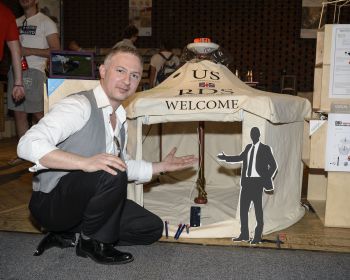Earthquake survivor Kerem graduates after inventing disaster shelter
By: Jacqui Bealing
Last updated: Thursday, 9 July 2015

Kerem Yilmaz with a scaled-down version of his rapid deployment shelter that will help people in disaster-affected areas.
A University of Sussex student who lived through a destructive earthquake graduates on Friday 17 July after using his time at the University to invent a lightweight shelter for victims of wars and natural disasters.
Kerem Yilmaz, who will receive a BSc in Product Design, was woken up in the middle of the night by an earthquake that rocked his family’s home in northern Turkey in 1999.
He describes holding his father’s hand and praying as the earthquake, which resulted in a death toll of over 17,000, shook the apartment where he was staying in the city of Düzce.
“We stood by the door and it felt like the ground was bubbling”, he remembers. “We were on the third floor of the apartment block, and I said to my dad, ‘This is the end.’ I closed my eyes and waited to die.”
Kerem and his relatives survived the earthquake, yet four of his uncles had their homes destroyed. About half a million people were made homeless as a result of the quake.
As a product design student at Sussex, Kerem put his terrifying experience to good use by inventing a lightweight shelter that can be used in the event of a war or natural disaster.
His ‘rapid deployment shelter’ is aimed at solving several flaws in the shelters being used at present. Kerem explains: “Most shelters need five people to erect them and take around two hours to put up, while my design can be put up by one person in 10 minutes.
“A lot of shelters come with written instructions, which can create language barriers for people who come to a country to help after a disaster. My shelter comes with pictures instead of written instructions, to remove these barriers.”
Kerem has also come up with a novel way of helping emergency workers find people in need of medical treatment: “There is a solar-powered recovery light on top of my shelter that can be activated by pulling a cord.
“This makes it easy to see who needs help, even in a camp with 10,000 shelters.”
Since exhibiting his shelter at the University’s product design degree show in April, Kerem has been approached by both public and private sector organisations interested in his idea.
After graduating he plans to continue searching for funding, with the aim of developing his design to the stage where it can be mass-produced.

